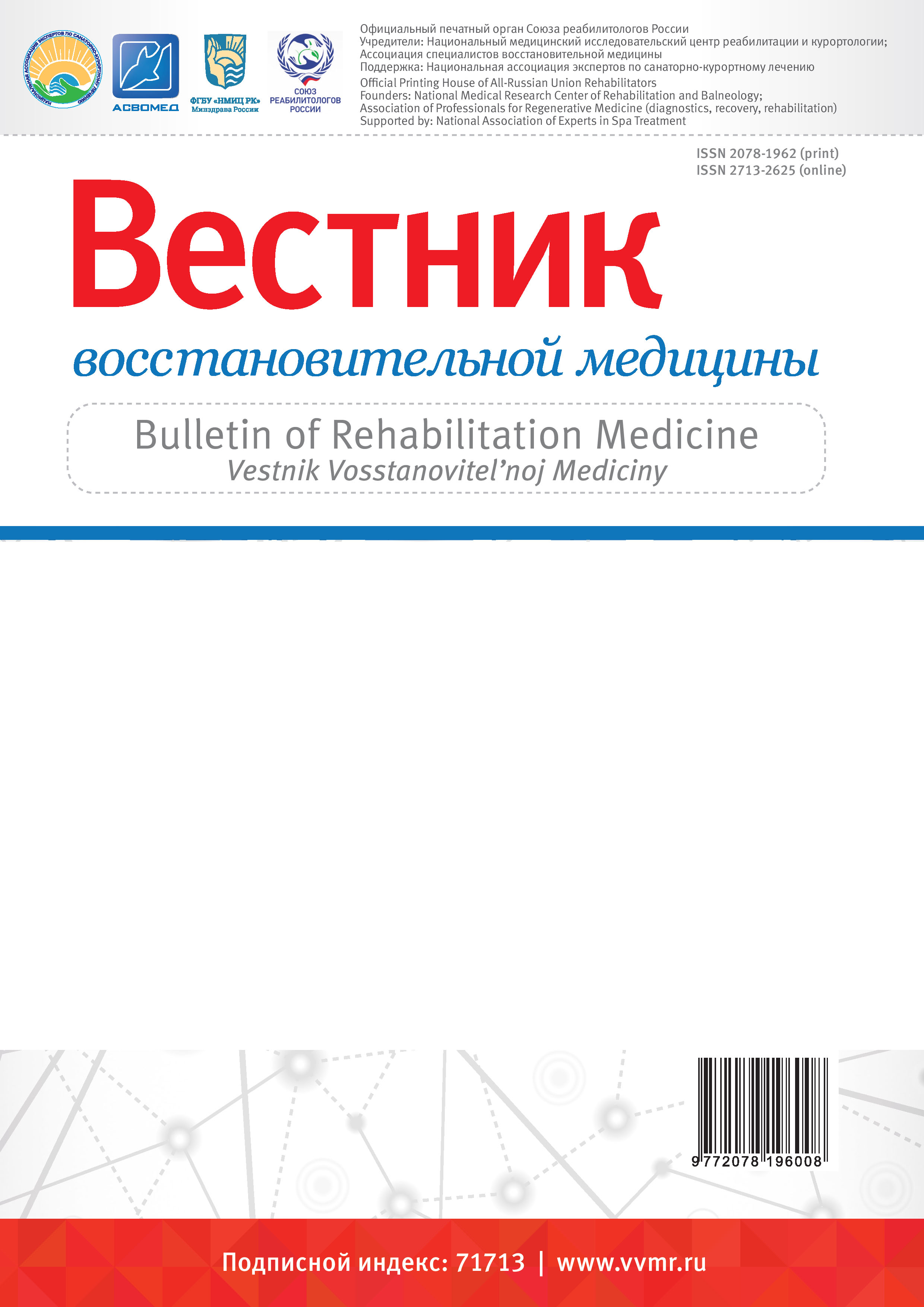Национальный медицинский исследовательский центр детской гематологии, онкологии и иммунологии им. Дмитрия Рогачева, Чехов, Россия
INTRODUCTION. Chronic fatigue syndrome is a condition, characterized by a severe fatigue that lasts continuously for more than 6 months and has a significant negative impact on the psychophysiological functions. Cancer-related fatigue is identified as an important symptom associated with cancer, associated with autonomic dysfunction. AIM. To reveal objective autonomic and neurodynamic indicators of the severity of CRF in children suffered of neuro-oncological diseases. MATERIAL AND METHODS. Children (8-17 years old) who were under dynamic observation after neuro-oncological diseases for more than six months (n=67) performed maximal tapping tasks, auditory-motor synchronization, and filled out the questionnaire «The Turkish Scale for the Assessment of Fatigue in Pediatric Oncology Patients Aged 7-18». Physiological indices (heart rhythm, peripheral temperature, skin conductance, breathing amplitude and frequency) were recorded at rest and during sensorimotor task. RESULTS AND DISCUSSION. The subscale “Sleep-related fatigue” positively correlates with the average frequency of maximum tapping and with the degree of its slowdown towards the end, which also correlates with the total score of the questionnaire. Statistically significant correlations of scores on the subscale “Subjective feelings of fatigue” with LF/HF and pNN50 at rest were revealed. The amplitude of thoracic respiration positively correlates with the scores of “Fatigue associated with daily activities”, “Subjective feeling of fatigue”, and the total score. Comparison of groups with a low and high total score of the questionnaire does not reveal statistically significant differences in the background indicators of heart rate variability, however, in the process of maximum tapping, the RMSSD and pNN50 indicators are higher, and the indicator of nonlinear heart rate analysis SD2/SD1 is lower in the group with low scores on the questionnaire. CONCLUSION. Children with cancer-related fatigue had reduced heart rate variability, lower parasympathetic tone and greater exhaustion during the tapping test. The combination of objective and subjective indicators reflects the dynamics of cancer-related fatigue and the rehabilitation process more reliably.
children, brain tumor, chronic fatigue syndrome, cancer-related fatigue, tapping test, autonomic functions, sensorimotor functions, questionnaire
1. Komaroff A.L. Advances in understanding the pathophysiology of chronic fatigue syndrome. JAMA. 2019; 322(6): 499-500. https://doi.org/10.1001/jama.2019.8312
2. Lim E.J., Ahn Y.C., Jang E.S. et al. Systematic review and meta-analysis of the prevalence of chronic fatigue syndrome/myalgic encephalomyelitis (CFS/ME). Journal of Translational Medicine. 2020; 18(1): 1-15. https://doi.org/10.1186/s12967-020-02269-0
3. Ho K.Y., Li W.H., Lam K.W.K. et al. Relationships among fatigue, physical activity, depressive symptoms, and quality of life in Chinese children and adolescents surviving cancer. European Journal of Oncology Nursing. 2019; (38): 21-27. https://doi.org/10.1016/j.ejon.2018.11.007
4. Schmidt M.E., Hermann S., Arndt V., Steindorf K. Prevalence and severity of long-term physical, emotional, and cognitive fatigue across 15 different cancer entities. Cancer Medicine. 2020; 9(21): 8053-8061. https://doi.org/10.1002/cam4.3413
5. Nap-van der Vlist M.M., Dalmeijer G.W., Grootenhuis M.A. et al. Fatigue in childhood chronic disease. Archives of Disease in Childhood. 2019; 104(11): 1090-1095. https://doi.org/10.1136/archdischild-2019-316782
6. Smith A. Cognitive impairments in Chronic Fatigue Syndrome Patients: Choice reaction time, encoding of new information, response organisation and selective attention. World Journal of Pharmaceutical and Medical Research. 2022; 8(4): 27-36.
7. Rasouli O., Gotaas M.E., Stensdotter A.K. et al. Neuropsychological dysfunction in chronic fatigue syndrome and the relation between objective and subjective findings. Neuropsychology. 2019; 33(5): 658 p. https://doi.org/10.1037/neu0000550
8. Sommer A., Grothus S., Grochowska K. et al. Assessing fatigue in children and adolescents: Psychometric validation of the German version of the PROMIS® Pediatric Short Form v2. 0-Fatigue 10a in school children and pediatric chronic pain patients. Quality of Life Research. 2022; 31(4): 1257- 1266. https://doi.org/10.1007/s11136-021-03032-8
9. Sevgili S., Sahin S., Akel B. S. Examination of Fatigue, Well-Being and Life Habits in Children with Cancer Diagnosis. Bezmialem Science. 2021; 9(4); 439-450. https://doi.org/10.14235/bas.galenos.2020.4394
10. Berger C., Demoor-Goldschmidt C. Models of Long-Term Follow-up for Cancer Patients: From Children to Adults, from Simple to Multi-Modal. Sur- vivorship Care for Cancer Patients. 2021: 61-70. https://doi.org/10.1007/978-3-030-78648-9_5
11. Penson A., van Deuren S., Bronkhorst E. et al. Methodology of the DCCSS later fatigue study: a model to investigate chronic fatigue in long-term survivors of childhood cancer. BMC Medical Research Methodology. 2021; 21(1): 1-12. https://doi.org/10.1186/s12874-021-01298-7
12. Winningham M., Nail L., Burke B. et al. Fatigue and the cancer experience: The state of the know1edge. Oncology Nursing Forum. 1994; (21): 23-36.
13. Bektas M., Kudubes A.A. Developing scales for the assessment of fatigue in Turkish pediatric oncology patients aged 13-18 and their parents. Asian Pacific Journal of Cancer Prevention. 2014; 15(22): 9891-9898. https://doi.org/10.7314/APJCP.2014.15.22.9891
14. Kudubes A.A., Bektas M., Ugur O. Developing a scale for the assessment of fatigue in pediatric oncology patients aged 7-12 for children and parents. Asian Pacific Journal of Cancer Prevention. 2015; 15(23): 10199-10207. https://doi.org/10.7314/APJCP.2014.15.23.10199
15. Deviaterikova A.A., Kasatkin V.V., Velichovsky B.B. The Validity and Reliability of the Turkish Scale for the Assessment of Fatigue in Pediatric Oncology Patients Aged 7-18 in Russia. Psychology in Russia: State of the Art. 2021; 14(1): 39-48. https://doi.org/10.11621/pir.2021.0104
16. Nelson M.J., Bahl J.S., Buckley J.D. et al. Evidence of altered cardiac autonomic regulation in myalgic encephalomyelitis/chronic fatigue syndrome: A systematic review and meta-analysis. Medicine. 2019; 98(43). https://doi.org/10.1097/MD.0000000000017600
17. Escorihuela R.M., Capdevila L., Castro J.R. et al. Reduced heart rate variability predicts fatigue severity in individuals with chronic fatigue syndrome/ myalgic encephalomyelitis. Journal of Translational Medicine. 2020; 18(1): 1-12. https://doi.org/10.1186/s12967-019-02184-z
18. Park H.Y., Jeon H.J., Bang Y.R., Yoon I.Y. Multidimensional comparison of cancer-related fatigue and chronic fatigue syndrome: the role of psycho- physiological markers. Psychiatry Investigation. 2019; 16(1): 71 p. https://doi.org/10.30773/pi.2018.10.26
19. Sheikh I.N., Roth M., Stavinoha P.L. Prevalence of Sleep Disturbances in Pediatric Cancer Patients and Their Diagnosis and Management. Children. 2021; 8(12): 1100 p. https://doi.org/10.3390/children8121100
20. Santoso A.M., Jansen F., de Vries R. et al. Prevalence of sleep disturbances among head and neck cancer patients: a systematic review and meta-anal- ysis. Sleep Medicine Reviews. 2019; (47): 62-73. https://doi.org/10.1016/j.smrv.2019.06.003
21. Kovaleva A.V., Anisimov V.N., Krasnoperov A.V. Tochnaya kolichestvennaya ocenka sluhomotornoy sinhronizacii u detey i vzroslyh s pomosch'yu programmno-apparatnogo kompleksa sensomotornoy ritmografii. Lechebnaya fizkul'tura i sportivnaya medicina. 2019; 153(3): 24-31.
22. McNames J., Aboy M. Reliability and accuracy of heart rate variability metrics versus ECG segment duration. Medical and Biological Engineering and Computing. 2006; 44(9): 747-756. https://doi.org/10.1007/s11517-006-0097-2
23. Nussinovitch U., Elishkevitz K.P., Kaminer K. et al. The efficiency of 10 second resting heart rate for the evaluation of short term heart rate variability indices. Pacing and Clinical Electrophysiology. 2011; 34(11): 1498-1502. https://doi.org/10.1111/j.1540-8159.2011.03178.x
24. Tayel M.B., AlSaba E.I. Poincaré plot for heart rate variability. International Journal of Biomedical and Biological Engineering. 2015; 9(9): 708-711. https://doi.org/10.5281/zenodo.1109321
25. Himelfarb M., Shatkin J.P. Pediatric insomnia. Child and Adolescent Psychiatric Clinics. 2021; 30(1): 117-129. https://doi.org/10.1016/j.chc.2020.08.004
26. Pfaff A., Jud A., Schlarb A. Systematic review on the association between sleep-related hyperarousal and child maltreatment. Sleep Medicine. 2021; (84): 219-226. https://doi.org/10.1016/j.sleep.2021.05.041
27. Tak L.M., Riese H., de Bock G.H. et al. As good as it gets? A meta-analysis and systematic review of methodological quality of heart rate variability studies in functional somatic disorders. Biological Psychology. 2009; 82(2): 101-110. https://doi.org/10.1016/j.biopsycho.2009.05.002
28. Lakoski S.G., Jones L.W., Krone R.J. et al. Autonomic dysfunction in early breast cancer: Incidence, clinical importance, and underlying mechanisms. American Heart Journal. 2015; 170(2): 231-141. https://doi.org/10.1016/j.ahj.2015.05.014
29. Fagundes C.P., Murray D.M., Hwang B.S. et al. Sympathetic and parasympathetic activity in cancer-related fatigue: more evidence for a physiological substrate in cancer survivors. Psychoneuroendocrinology. 2011; 36(8): 1137-1147. https://doi.org/10.1016/j.psyneuen.2011.02.005
30. Lo P.C., Tsai P.H., Kang H.J., Tian W.J.M. Cardiorespiratory and autonomic-nervous-system functioning of drug abusers treated by Zen meditation. Journal of Traditional and Complementary Medicine. 2019; 9(3): 215-220. https://doi.org/10.1016/j.jtcme.2018.01.005






